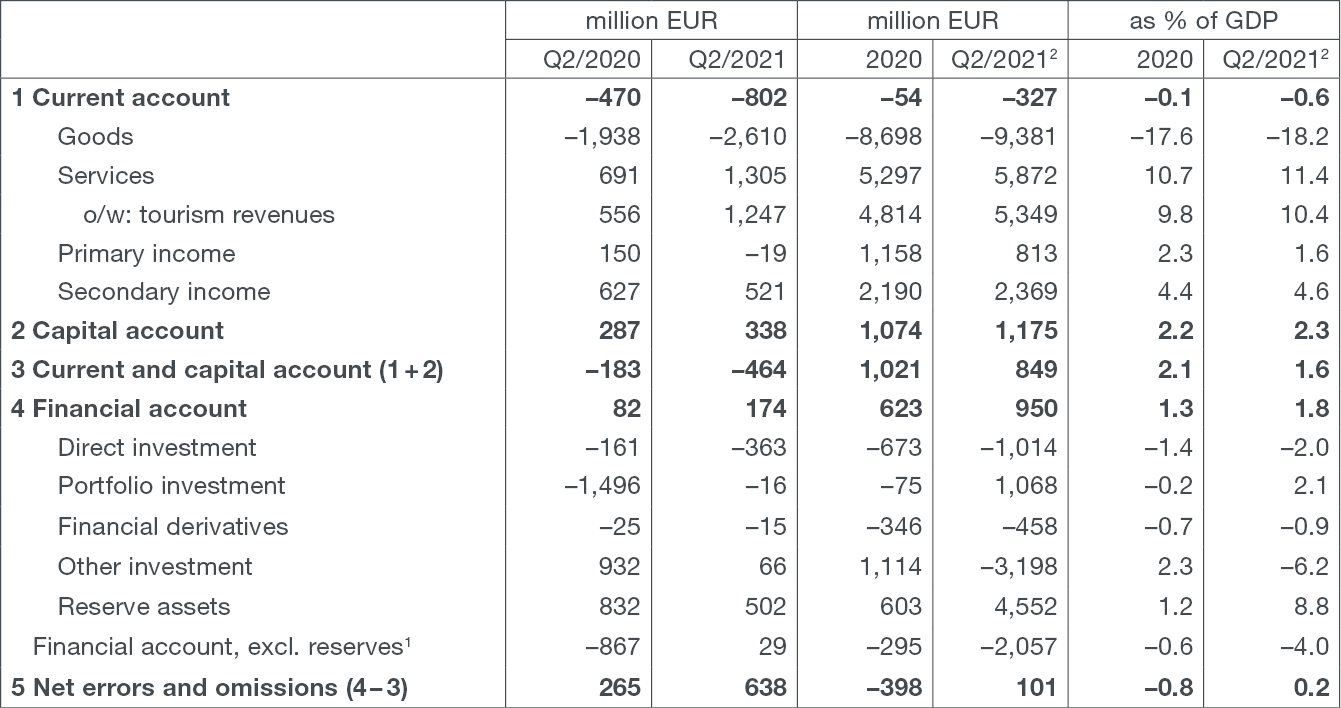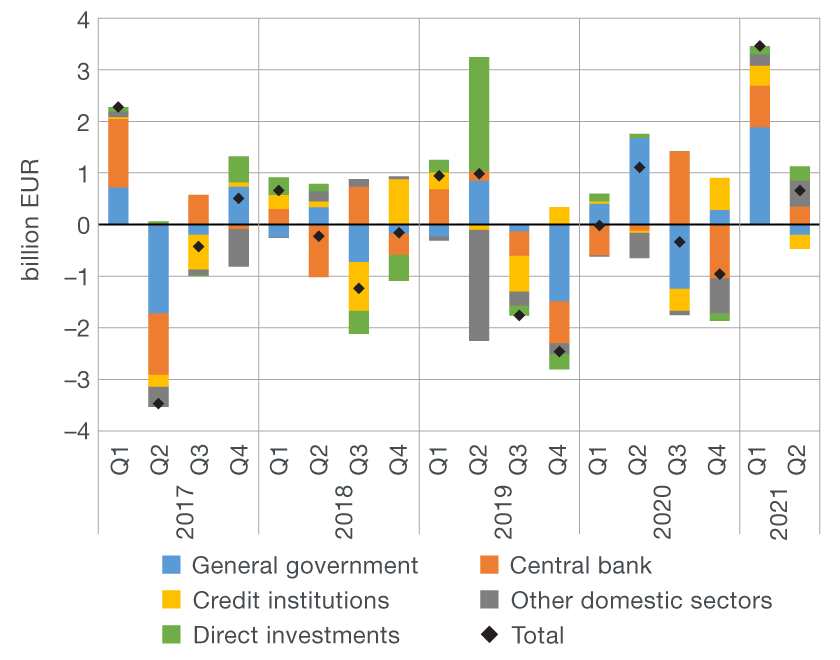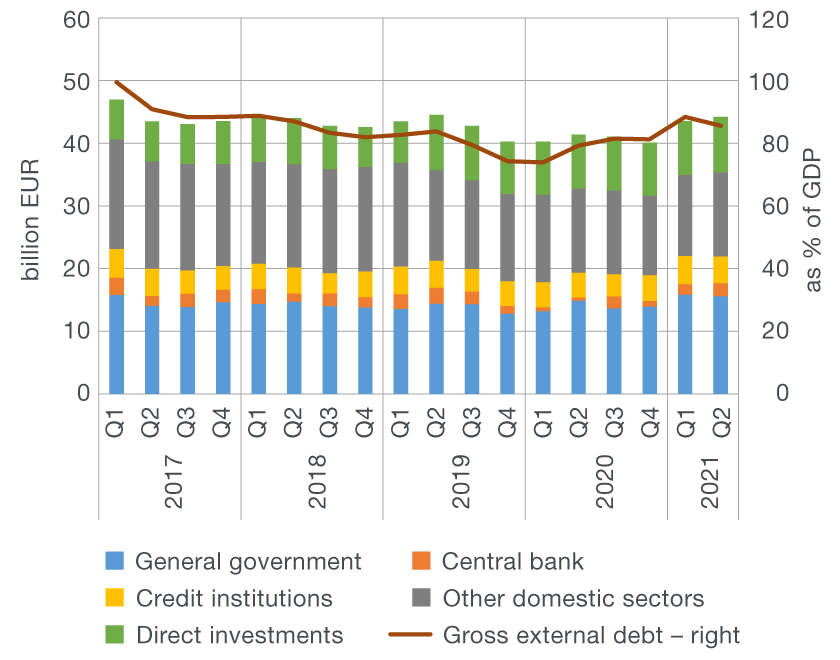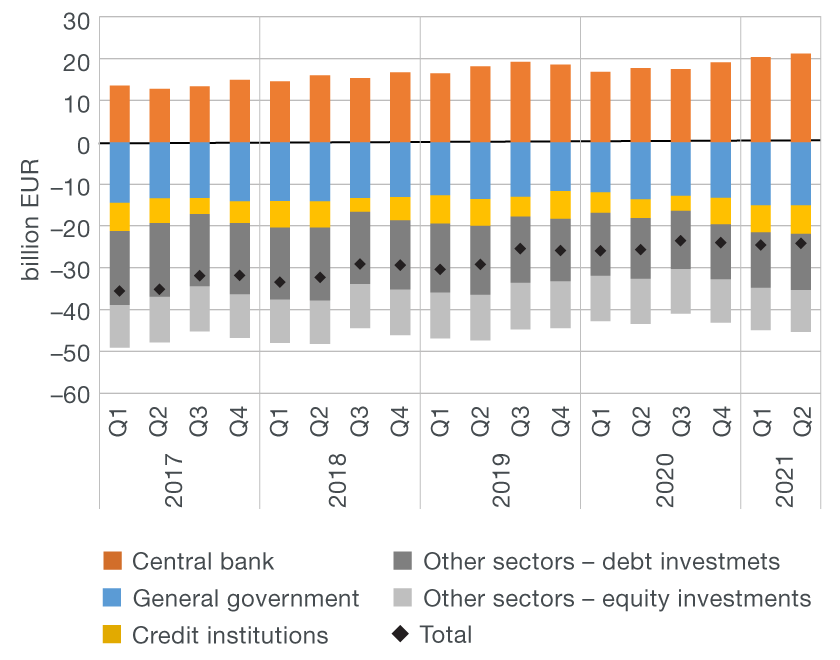From August 2023 the comments on statistics, a short description of selected, recently issued statistical data in the area of monetary statistics and the non-residents sector statistics, are no longer published. They are replaced by Statistical releases.
Comments on the balance of payments, gross external debt and the international investment position in 2Q 2021
The current and capital account of the balance of payments ran a deficit of EUR 0.5bn in the second quarter of 2021, which is an increase of EUR 0.3bn from the same period of the previous year. If the last four quarters are observed, the surplus in the current and capital account in the period up to the end of June 2021 totalled 1.6% of GDP, which was 0.4 percentage points less than in the entire 2020.
Gross external debt stood at 85.6% of GDP at the end of June 2021, decreasing by 2.8 percentage points from the end of March, thanks to nominal GDP growth. In the same period, the ratio of net international investment position to GDP improved from –49.8% of GDP to –46.8% of GDP.
The current and capital account of the balance of payments ran a deficit of EUR 0.5bn in the second quarter of 2021, which was a deterioration in the balance of EUR 0.3bn from the same period of the previous year (Figure 1a). This can primarily be attributed to the widening of the foreign trade deficit and, to a lesser extent, the deterioration in the primary income account balance, which was driven by a revival in domestic demand, restoration of supply chains that were disrupted by the outbreak of the pandemic, as well as improved performance of foreign-owned banks and enterprises. At the same time, the unfavourable developments were mitigated by the rise in net exports of services, particularly tourism revenues. If the last four quarters are observed, the surplus in the current and capital account in the period up to the end of June 2021 totalled 1.6% of GDP, which was 0.4 percentage points less than in the entire 2020 (Table 1).
Foreign trade in goods picked up noticeably in the second quarter of 2021, with both exports and imports growing sharply compared to the same period of 2020, by 44.8% and 40.5%, respectively. These developments were in part due to the base effect associated with the sharp contraction in foreign trade in spring 2020 triggered by the onset of the COVID-19 pandemic and the imposition of strict epidemiological measures. However, it should be noted that exports of goods have been perceptibly higher in 2021 so far (by 20.8%) than in the same period of the pre-crisis 2019, with imports also slightly exceeding the pre-crisis level (by 4.0%). While exports grew faster than imports on an annual level, the growth of imports in absolute terms exceeded the growth of exports due to the much larger imports base. As a result, the merchandise trade deficit was EUR 0.7bn larger than in the same period of the previous year.
Boosted by the sharp growth in revenues from tourist spending of foreign guests, the surplus in foreign trade in services was EUR 0.6bn larger in the second quarter of 2021 than in the same period of 2020, when the outbreak of the pandemic brought foreign tourist arrivals and tourist activity almost to a complete halt. Notwithstanding the increase, revenues from tourism were modest in the second quarter of 2021 when compared with the record-high of 2019, amounting to slightly more than half of the revenues from two years ago.
The deterioration in the balance in the primary income account[1] in the second quarter of 2021 relative to the same period of 2020 (of EUR 0.2bn) was a result of larger expenditures on direct equity investments due to the increase in profits of foreign-owned banks and enterprises (primarily in real estate activities, trade, construction and oil industry). These unfavourable developments were partly mitigated by the growth in revenues from compensation of persons temporarily employed abroad. At the same time, the overall surplus in the secondary income and capital transaction accounts edged down (by EUR 54.3m), owing to the smaller use of funds for current transfers allocated from the EU budget, which was partially offset by the steady increase in net revenues from personal transfers.
Figure 1 Balance of payments
| a) Current and capital account | b) Financial account |
 |
 |
1 Sum of the last four quarters.
2 Excluding the change in the gross international reserves and foreign liabilities of the CNB.
Note: In the figure showing the financial account, the positive value denotes net capital outflow abroad and the negative value denotes net capital inflow.
Source: CNB.
The financial account of the balance of payments recorded a net capital outflow of EUR 0.2bn in the second quarter of 2021 (Figure 1b), an increase of EUR 0.1bn from the same period of the previous year. Broken down by individual accounts, this year’s net capital outflow was largely the outcome of the growth in gross international reserves. In addition, net liabilities in the account of other investments declined slightly. At the same time, the foreign direct investment account saw a net capital inflow, that is, the rise in net liabilities, while no major changes were seen in portfolio investments, as the increase in government liabilities arising from short-term debt securities was offset by the roughly equal growth in assets associated mostly with investments of domestic institutional investors in foreign shares and equity holdings.
The net inflow of foreign direct investments stood at EUR 0.4bn in the second quarter of 2021, growing by EUR 0.2bn from the same period of the previous year. The growth was spurred by larger retained profits of banks and enterprises in foreign ownership arising from higher profitability, as well as larger equity investments in Croatia, which were in part the result of the absence of new investment during the last year’s lockdown. Significant new direct equity investments in Croatia in 2021, other than that made in the real estate sector, were also made in the automotive industry. In the same period, the increase in debt liabilities of domestic sectors with respect to affiliated foreign creditors was paired with much stronger growth in the assets of domestic sectors based on debt instruments, which was associated with lending to affiliated enterprises abroad.
The mild net capital outflow (of EUR 0.1bn) in the other investment account in the second quarter of 2021 was the result of a slightly larger increase in assets than in liabilities. Central bank’s assets grew the most, driven by the rise in banks’ funds within the TARGET2 system[2] (of EUR 0.6bn), while the growth in central bank’s liabilities (of EUR 0.4bn) was the result of the increased volume of repo transactions, which have a neutral impact on the overall financial account balance because they simultaneously raise international reserves by the same amount.[3] The net outflow of capital was also due to a reduction in government net liabilities, while the increase in net liabilities of credit institutions and other domestic sectors had the opposite effect.
The noticeable growth in gross international reserves in the second quarter of 2021 (of EUR 0.5bn) was associated with the larger purchase of foreign exchange from the government and the larger volume of repo transactions. As a result, gross international reserves stood at EUR 21.5bn at the end of June 2021, growing by 13.7% from the end of 2020.
Table 1 Balance of payments

1 Excluding the change in the gross international reserves and foreign liabilities of the CNB. The investment of a portion of international reserves in reverse repo agreements results in a simultaneous change in CNB assets (recorded in the reserve assets account) and liabilities (recorded in the other investment account) and thus has a neutral impact both on changes in the central bank’s net foreign position and the overall financial account balance.
2 Sum of the last four quarters.
Note: The positive value of financial transactions denotes net capital outflow abroad and the negative value denotes net capital inflow.
Source: CNB.
The stock of gross external debt grew by 0.7bn in the second quarter of 2021 (Figure 2a). The sharpest increase (of EUR 0.8bn) was seen in the debt of other domestic sectors (private non-financial corporations), including their liabilities to affiliated creditors, followed by that of the central bank (of EUR 0.4bn), as a result of the said increase in the volume of repo transactions. By contrast, credit institutions and general government reduced their debt, by EUR 0.3bn and EUR 0.2bn, respectively. Accordingly, total gross external debt stood at EUR 44.2bn or 85.6% of GDP at the end of June 2021, decreasing by 2.8 percentage points from the end of March, thanks to nominal GDP growth (Figure 2b).
Figure 2 Gross external debt
| a) Change in gross external debt | b) Stock of gross external debt |
 |
 |
Note: Changes in gross external debt are a result of net transactions of domestic sectors and exchange rate and other adjustments.
Source: CNB.
The growth in gross external debt in absolute terms coincided with an even larger increase in debt claims of domestic sectors (primarily central bank's assets), which finally led to a reduction in net external debt of EUR 0.7bn in the second quarter of 2021. Thus, net external debt stood at EUR 7.6bn at the end of June, or 14.7% of GDP, down by 2.0 percentage points from the end of March.
The fall in net external debt led to an improvement in the net international investment position, from EUR –24.5bn at the end of March to EUR –24.2bn at the end of June 2021. The net foreign position of the central bank improved the most, which was mitigated by the deterioration in the position of credit institutions (Figure 3a). As a result of the decrease in net external debt, the relative indicator of the net international investment position improved, from –49.8% of GDP at the end of March to –46.8% of GDP at the end of June 2021 (Figure 3b).
Figure 3 International investment position (net)
| a) Position by sector | b) Relative indicator by type of investment |
 |
 |
Note: The international investment position (net) equals the difference between domestic sectors' foreign assets and liabilities at the end of a period. The negative value of the net international investment position indicates that foreign liabilities of Croatian residents are greater than their foreign assets. Included are assets and liabilities based on debt instruments, equity investments, financial derivatives, and other instruments. Figure 3b includes financial derivatives and other liabilities in the net debt investment position.
Source: CNB.
Data revision
Data on the balance of payments, gross external debt and the international investment position are revised for the previous periods. For more details see External statistics revision.
Detailed balance of payments data
Detailed gross external debt data
Detailed data on the international investment position
-
With the release of data for the second quarter of 2021, historical data for primary and secondary income accounts were revised. ↑
-
Banks’ funds within the TARGET2 system account for central bank’s foreign assets, but they are not part of international reserves. ↑
-
The investment of a portion of international reserves in reverse repo agreements results in a simultaneous change in CNB assets (recorded in the gross reserve assets account) and liabilities (recorded in the other investment account) and thus has a neutral impact both on changes in the central bank's net foreign position and the overall financial account balance. ↑
